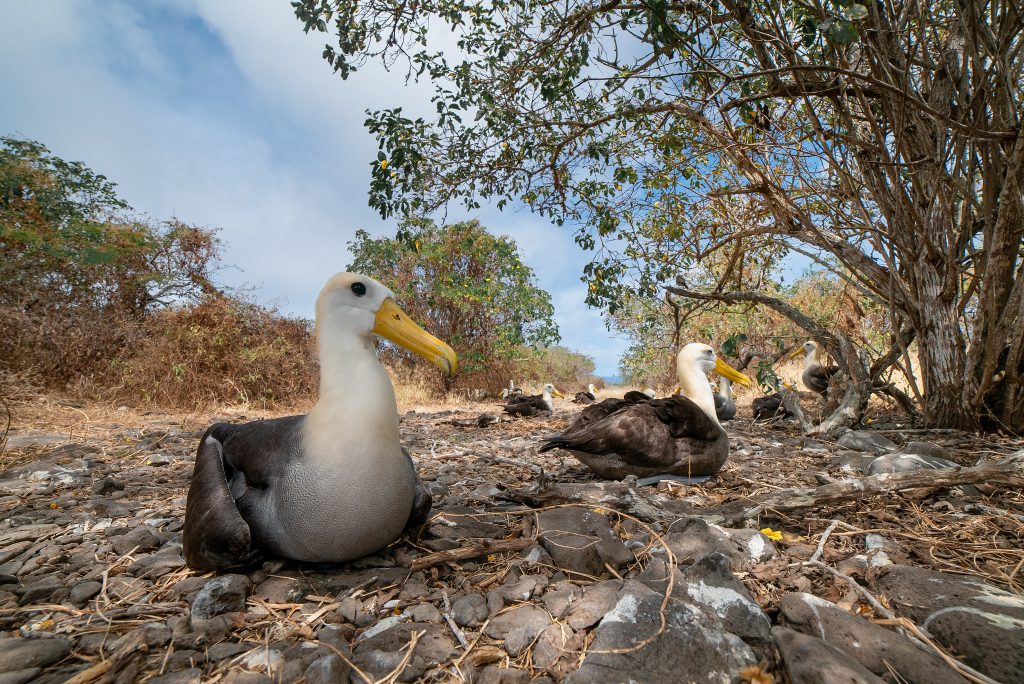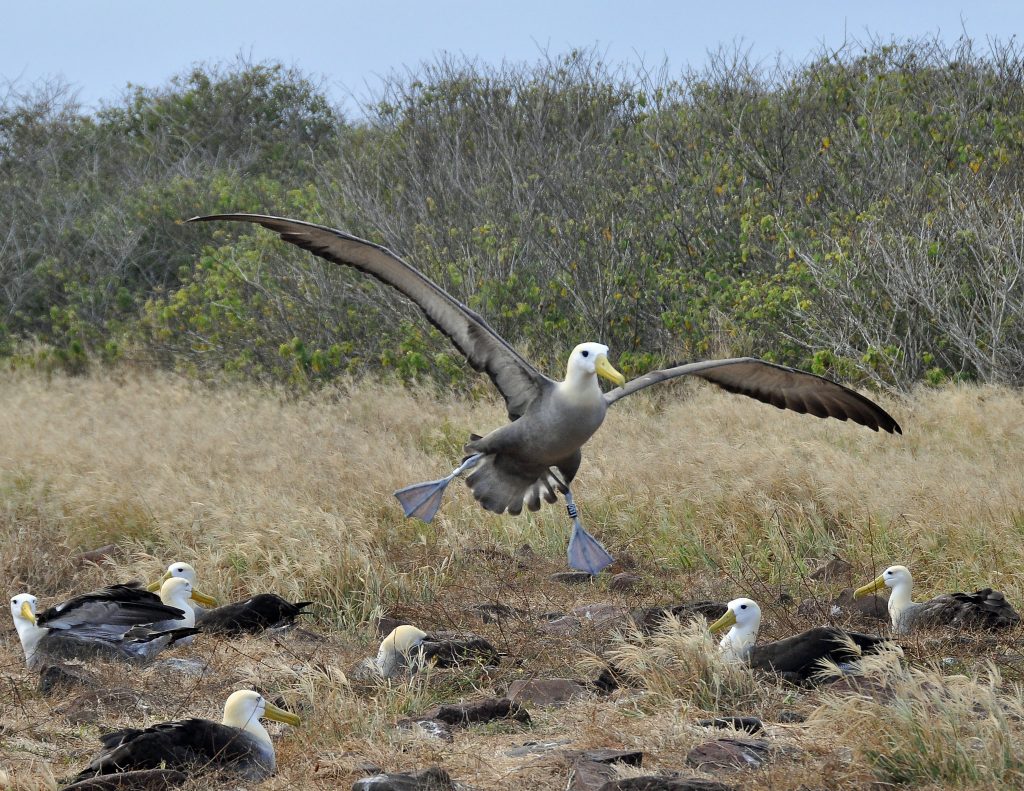On the Wings of Conservation
Date: January 10, 2022.
by Dr. James Gibbs
Vice President of Science and Conservation
<<Versión en español abajo>>

Midnight approaches, the heat of the day has dissipated, and a cool ocean breeze brings a chill to Española Island, where we are camped at the top of the bold cliffs of the Island’s southern coast.
As I lie inside my sleeping bag, a cacophony punctuates the silence. Episodes of hooting, honking, whistling, and clattering emanate from somewhere off in the dense, dark thicket that surrounds us. I realize the sounds are from pairs of Waved Albatross enthralled in their bonding ritual: clapping their bills together, bobbing, and calling out.
Then suddenly, a lumbering tortoise’s shell thumps hollowly as it rams past a lava rock, followed by the crack of a branch that gives way to the powerful passing tortoise. Española Giant Tortoises are making a comeback and appearing in parts on the Island where they have not been seen in over 200 years, such as our campsite near this albatross colony on the southern side of Española Island.
In 1960, the Española Giant Tortoise was on the brink of extinction as only 15 tortoises remained. Iniciativa Galápagos — a joint program of the Galápagos National Park Directorate and Galápagos Conservancy — has helped rewild the population. Now over 3,000 tortoises live wild and free on the Island, but their numbers are still a tiny fraction of the estimated population of tortoises before they were hunted to near extinction by mariners in centuries past.
Remarkably, the entire global population of the Waved Albatross — the only species of tropical albatross on the planet — also uses Española as its sole nesting area. The species is considered Critically Endangered due to increasing by-catch in long-line fisheries on its foraging areas off the coast of Peru as well as an incursion of woody plants into its nesting areas caused by the collapse of tortoise populations.
But the Giant Tortoises are now returning to help. With their hulking bodies and boundless appetites, tortoises clear woody vegetation from areas that albatrosses use as pathways to take flight and land. Without these runways, nesting is not possible for many of these birds.
Indeed, our intrepid staff from Galápagos Conservancy are on Española Island to study “Albatross Airports,” and the tortoises that can engineer them.

In the morning we begin the first island-wide survey of the Waved Albatross in over 50 years. For 10 days, we cut our way through endless thickets, our clothes shredded by their clawing branches. We find long openings in the thickets, where large clusters of albatross gather. The birds are mostly stationary and silent, but a brief gust of wind can trigger an albatross to suddenly snap into action, galloping down the narrow runway, webbed feet slapping against the ground, and claws digging into the turf. Its eight-foot wingspan extends as the bird gradually takes flight.
We cringe as one doesn’t clear the top of the thicket at the runway’s end, wings smacking into branches, the massive bird crumpling up and falling through the trees into the understory, slowly regathering itself and then marching back to the top of the runway to try again. Some birds are not so lucky — over the next few days we find albatrosses dead in trees, like scarecrows hanging by their wings or necks.
In our wanderings, we start to see a pattern. About two-thirds of the population — many thousands of albatross — nest amongst the mostly impenetrable shrubs and trees in the Island’s interior near the few areas with openings in the vegetation. On the final day of the expedition, we visit 13 tortoise-proof fenced-in areas in the center of the Island. These are experiments to measure the effect of tortoises on the vegetation. We spend two days carefully measuring every plant inside and outside the tortoise exclosures. What we see first-hand confirms what we have already seen in high-definition NASA satellite imagery of the Island: wherever tortoises occur on Española, woody plants are declining. Where there are few or no tortoises (which coincidentally is where albatrosses prefer to nest) woody plants keep growing in vigorously.
It will take many decades for the Española Giant Tortoise to return to its historic numbers and start fully re-engineering the vegetation of Española Island. The Waved Albatross does not have the time to wait. So we as conservationists must intervene. There are two essential solutions. First, we need to immediately start selectively cutting back thorny scrub in and around the albatross airports to assist the birds as they take flight. Second, we need to attract tortoises back to the areas where albatrosses nest so they keep the albatross runways open. Planting cactus (the tortoises’ favorite food) and providing temporary water sources are effective ways to help rebuild the tortoise population within the albatross nesting areas and encourage their engineering activity.
We urgently need your generous support to undertake these ambitious solutions, to ensure that the spectacular island of Española returns to its former glory with an army of Giant Tortoises manicuring shrubs to provide safe runways for the endemic Waved Albatross to access their nesting areas. Their fates are up to us.
En Alas De La Conservación
por el Dr. James Gibbs
Vicepresidente de Ciencia y Conservación
A medida que se acercaba la medianoche, el calor del día se había disipado y una fresca brisa marina trajo algo de frescura a la isla Española, donde acampábamos en lo alto de los acantilados de la costa sur de la isla.
Mientras descansaba en mi saco de dormir, un sonido áspero rompió el silencio de la noche. De algún lugar de la densa y oscura maleza que nos rodeaba, llegaban sonidos de cascabeles, cuernos, silbatos y matracas. De repente, me di cuenta de que los sonidos provenían de aves, eran varias parejas de albatros de Galápagos realizando su clásico ritual de cortejo meneándose, tocándose los picos, y emitiendo sonidos fuertes.
De repente, el caparazón de una enorme y pesada tortuga golpea con fuerza una roca de lava, y se escucha de inmediato el sonido de una rama de un árbol que se rompe y se abre paso a la poderosa tortuga. Las poblaciones de tortugas gigantes de Española se están recuperando, ahora aparecen en lugares de la isla donde no se las había visto en más de 200 años, como en nuestro campamento, cerca de esta colonia de albatros en el lado sur de la isla.
En 1960, la tortuga gigante de Española estaba en peligro de extinción pues quedaban apenas 15 ejemplares en la isla. Sin embargo, la Iniciativa Galápagos -un programa conjunto de la Dirección del Parque Nacional Galápagos y Galápagos Conservancy- ha ayudado a restaurar la población. Gracias a este programa, hoy en día, más de 3.000 tortugas viven libremente en estado silvestre en la isla, pero su número aún representa una pequeña fracción de la población estimada de tortugas que había hace siglos, antes de que los marineros las cazaran hasta el punto de casi extinguirlas.
Sorprendentemente, toda la población mundial de albatros de Galápagos -la única especie de albatros tropical del mundo- también anida únicamente en la isla Española. Esta especie, es considerada en Peligro Crítico debido al aumento de captura incidental de la pesca con palangre en las áreas de alimentación frente a las costas de Perú, y también por la invasión de plantas leñosas en sus sitios de anidación debido al colapso de las poblaciones de tortugas.
Pero las tortugas gigantes ahora están de vuelta para ayudar. Con sus corpulentos cuerpos y apetito insaciable, las tortugas limpian áreas de vegetación leñosa que los albatros utilizan como pistas de vuelo y aterrizaje. Sin estas pistas, muchas especies de aves no pueden construir nidos.
De hecho, nuestro intrépido personal de Galápagos Conservancy está en Española estudiando los “aeródromos de albatros” y las tortugas que podrían diseñarlos.

Después de más de 50 años,, iniciamos el primer censo del albatros de Galápagos en toda la isla. Durante 10 días, nos abrimos paso a través de interminables matorrales, destrozando nuestra ropa para abrirnos camino por las ramas que nos arañaban. Encontramos largas aberturas en los matorrales, donde se habían congregado grandes grupos de albatros. La mayoría de las aves están casi siempre inmóviles y en silencio, pero una breve ráfaga de viento puede hacer que un albatros entre en acción, galopando por la estrecha pista, golpeando el suelo con sus patas palmeadas y clavando sus garras en la hierba. Su envergadura de dos metros se extiende a medida que el ave levanta el vuelo.
Nos estremecemos cuando uno de ellos no supera la cima del matorral al final de la pista y sus alas chocan contra las ramas, el enorme pájaro se desploma y cae a la vegetación, se reincorpora lentamente y vuelve a marchar hacia la cima de la pista para intentarlo nuevamente. Tristemente algunas aves no tienen tanta suerte: en los días siguientes encontramos albatros muertos en los árboles, como espantapájaros colgados de las alas o el cuello.
En nuestro recorrido por la isla, empezamos a notar un patrón en los albatros. Alrededor de dos tercios de la población -varios miles de albatros- anidan entre los arbustos y árboles, en su mayoría impenetrables, en el interior de la isla, cerca de las pocas zonas con aberturas en la vegetación. El último día de la expedición visitamos 13 zonas cercadas, a prueba de tortugas en el centro de la isla. Se trata de experimentos para medir el efecto de las tortugas en la vegetación. Pasamos dos días midiendo cuidadosamente cada planta dentro y fuera de los cercados para tortugas. Lo que notamos de primera mano confirma lo que ya hemos visto en imágenes satelitales de alta definición de la NASA de la isla: donde hay tortugas en Española, las plantas leñosas están disminuyendo. Donde hay pocas tortugas o ninguna (que casualmente es donde prefieren anidar los albatros) las plantas leñosas siguen creciendo vigorosamente.
Harán falta muchas décadas para que la población de tortugas gigantes de Española recupere su número histórico y empiece a rediseñar por completo la vegetación de la isla. El albatros de Galápagos no tiene tiempo para esperar, así que nosotros, como conservacionistas, debemos intervenir. Hay dos soluciones esenciales, en primer lugar, tenemos que empezar de inmediato a talar selectivamente los matorrales espinosos en los aeropuertos de albatros y sus alrededores para ayudar a las aves en su vuelo. En segundo lugar, tenemos que atraer de nuevo a las tortugas a las zonas donde anidan los albatros para que mantengan abiertas las pistas de aterrizaje de los albatros. Plantar cactus (el alimento favorito de las tortugas) y proporcionar fuentes temporales de agua son formas eficaces de ayudar a restaurar la población de tortugas en las zonas de anidamiento de los albatros y fomentar su actividad ingenieril.
Necesitamos urgentemente su generoso apoyo para emprender estas ambiciosas soluciones, a fin de garantizar que la espectacular isla Española recupere su antiguo esplendor con un ejército de tortugas gigantes moldeando arbustos para proporcionar pistas de aterrizaje seguras y acceso a las zonas de anidación de los albatros especie endémica del Archipiélago de Galápagos. ¡Su futuro depende de nosotros!



